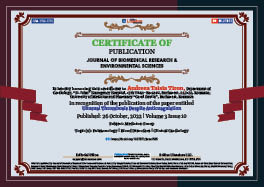Andreea Taisia Tiron, Anca Filofteia Briceag and Alice Lavinia Balaceanu
Volume3-Issue10
Dates: Received: 2022-10-05 | Accepted: 2022-10-25 | Published: 2022-10-26
Pages: 1244-1248
Abstract
Background: Pulmonary Embolism (PE) is a life-threatening condition with annual incidence ranging from 39 to 115 cases per 100,000 population [1]. Along with many other causes, neoplasia is one of the highest risk factors for pancreatic, lung, gastric, cerebral and haematological cancer [2]. Patients with neoplasia often have venous thromboembolism (VTE) during the course of the disease, but occasionally neoplasia is diagnosed as secondary to VTE.
Case Presentation: A 55-year-old man known with high blood pressure and dyslipidaemia is diagnosed with bilateral distal Deep Venous Thrombosis (DVT) and treated with a factor Xa inhibitor. Two months later he is admitted for fatigue, dry cough, unwanted weight loss of approximately 5kg for a month and progressive exertion dyspnea. The echocardiographic examination reveals dilated right chambers with thrombus in the Right Ventricle (RV). The suspicion of pulmonary embolism it was confirmed on thoracic contrast CT examination. Large bilateral mediastinal adenopathies and a right lung nodule were also visualised on lung CT scan. The patient was treated with unfractionated heparin, slow-acting nitrate, aspirin, calcium blocker, with the disappearance of the thrombus from the right ventricle. Bronchoscopy showed a lesion near the right main bronchus. The diagnosis of pulmonary adenocarcinoma is confirmed histopathologically on the sample obtained at bronchoscopy and from the mediastinal lymph node obtained at mediastinoscopy. The patient was referred to the oncology service for specialised treatment.
Conclusion: VTE under anticoagulant treatment should always raise some suspicions and other causes should be sought. Undiagnosed neoplasms , drug resistance or drug interactions, thrombophilias are some of the causes that should be suspected in case of thrombosis under therapeutic anticoagulant.
FullText HTML
FullText PDF
DOI: 10.37871/jbres1585
Certificate of Publication

Copyright
© 2022 Tiron AT, et al. Distributed under Creative Commons CC-BY 4.0
How to cite this article
Tiron AT, Briceag AF, Balaceanu AL. Unusual Thrombosis Despite Anticoagulation. 2022 Oct 26; 3(10): 1244-1248. doi: 10.37871/jbres1585, Article ID: JBRES1585, Available at: https://www.jelsciences.com/articles/jbres1585.pdf
Subject area(s)
References
- Wendelboe AM, Raskob GE. Global Burden of Thrombosis: Epidemiologic Aspects. Circ Res. 2016 Apr 29;118(9):1340-7. doi: 10.1161/CIRCRESAHA.115.306841. PMID: 27126645.
- Timp JF, Braekkan SK, Versteeg HH, Cannegieter SC. Epidemiology of cancer-associated venous thrombosis. Blood. 2013 Sep 5;122(10):1712-23. doi: 10.1182/blood-2013-04-460121. Epub 2013 Aug 1. PMID: 23908465.
- Blom JW, Osanto S, Rosendaal FR. The risk of a venous thrombotic event in lung cancer patients: higher risk for adenocarcinoma than squamous cell carcinoma. J Thromb Haemost. 2004 Oct;2(10):1760-5. doi: 10.1111/j.1538-7836.2004.00928.x. PMID: 15456487.
- Li Y, Xin G, Li S, Dong Y, Zhu Y, Yu X, Wan C, Li F, Wei Z, Wang Y, Zhang K, Chen Q, Niu H, Huang W. PD-L1 Regulates Platelet Activation and Thrombosis via Caspase-3/GSDME Pathway. Front Pharmacol. 2022 Jun 15;13:921414. doi: 10.3389/fphar.2022.921414. PMID: 35784685; PMCID: PMC9240427.
- Rajat Thawani, Thomas Kartika, Benjamin Elstrott, Elizabeth Batiuk, Lilian Chen, Nattapron Tun, Nicholas Taflin, Derrick Law Tao, Malinda T West, Joseph J Shatzel. PD-L1 and Tumor Mutational Burden Are Not Predictive of Thrombosis in a Cohort of 1,221 Patients with Solid Organ Malignancies. Blood. 2021.
- Mir Seyed Nazari P, Berghoff AS, Preusser M, Moik F, Posch F, Ricken G, Riedl J, Hell L, Marosi C, Hainfellner JA, Pabinger I, Ay C. Association of programmed cell death ligand 1 and circulating lymphocytes with risk of venous thromboembolism in patients with glioma. ESMO Open. 2020 May;5(3):e000647. doi: 10.1136/esmoopen-2019-000647. PMID: 32424065; PMCID: PMC7239522.
- Scott D, Brenner B, Buller HR, et al. Oral Rivaroxaban for Symptomatic Venous Thromboembolism. 2010;2499-2510.
- Mazzolai L, Ageno W, Alatri A, Bauersachs R, Becattini C, Brodmann M, Emmerich J, Konstantinides S, Meyer G, Middeldorp S, Monreal M, Righini M, Aboyans V. Second consensus document on diagnosis and management of acute deep vein thrombosis: updated document elaborated by the ESC Working Group on aorta and peripheral vascular diseases and the ESC Working Group on pulmonary circulation and right ventricular function. Eur J Prev Cardiol. 2022 May 27;29(8):1248-1263. doi: 10.1093/eurjpc/zwab088. PMID: 34254133.
- Deborah Schrag et co, CANVAS Investigators. The comparative effectiveness of direct oral anti-coagulants and low molecular weight heparins for prevention of recurrent venous thromboembolism in cancer: The CANVAS pragmatic randomized trial. Journal of Clinical Oncology. 2021;39:12020-12020.
- Ea A, Labedi N, Barba M, et al. Anticoagulation for the long-term treatment of venous thromboembolism in patients with cancer ( Review ). 2013;(6).
- Louzada ML, Carrier M, Lazo-Langner A, Dao V, Kovacs MJ, Ramsay TO, Rodger MA, Zhang J, Lee AY, Meyer G, Wells PS. Development of a clinical prediction rule for risk stratification of recurrent venous thromboembolism in patients with cancer-associated venous thromboembolism. Circulation. 2012 Jul 24;126(4):448-54. doi: 10.1161/CIRCULATIONAHA.111.051920. Epub 2012 Jun 7. PMID: 22679142.






























































